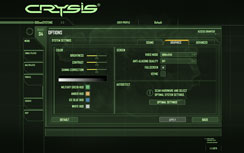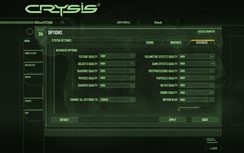Zotac GeForce 8800 GT 512MB AMP! Edition
Written by Tim Smalley
February 11, 2008 | 08:04
Tags: #512 #8800 #amp #benchmark #edition #factory #g92 #geforce #gt #overclock #overclocking #review #warranty

Crysis
Publisher: Electronic ArtsWhat can we say about this game that hasn’t been said already? Crysis is probably the most anticipated game on the PC last year and was released on November 16th 2007.
Crysis is seen by many as the poster boy for DirectX 10 and it will make your system cry, quite literally – it’s a monster! It doesn’t come as much of a surprise then, that the graphics are something special – they’re above and beyond anything we’ve ever seen in a PC game.
We tested the game under both DirectX 9.0 and DirectX 10 with the 1.1 patch applied. We used a custom timedemo recorded on the Island map which is more representative of gameplay than the built-in benchmark that renders things much faster than you’re going to experience in game. We found that around 25-30 fps in our timedemo was sufficient enough to obtain a playable frame rate through the game. It’s a little different to other games in that the low frame rates still appear to be quite smooth.
For our testing under both DirectX 9.0 and DirectX 10, we set the majority of the in-game settings to high, with physics and post processing set to medium. Because of how intense the game is, we tested with both anti-aliasing and anisotropic filtering disabled at resolutions above 1280x1024 for the time being. There is currently no support for anisotropic filtering in the game, but you can still force it from the driver control panel.
DirectX 9.0
Crysis
1280x1024 2xAA 0xAF, High Detail, Medium Physics, Medium Post Processing, DirectX 9.0
- Nvidia GeForce 8800 Ultra 768MB
- BFGTech GeForce 8800 GTS 512MB OC
- Zotac GeForce 8800 GT 512MB AMP! Edition
- Nvidia GeForce 8800 GTS 512MB
- Nvidia GeForce 8800 GTX 768MB
- Nvidia GeForce 8800 GT 512MB
- ATI Radeon HD 3870 512MB CrossFire
- ATI Radeon HD 3870 X2 1GB
- Sapphire Radeon HD 3870 512MB ATOMIC
- ATI Radeon HD 3870 512MB
-
-
34.6
-
22.0
-
-
-
32.8
-
20.0
-
-
-
32.6
-
21.0
-
-
-
32.1
-
17.0
-
-
-
31.4
-
20.0
-
-
-
29.3
-
18.0
-
-
-
27.2
-
12.0
-
-
-
27.0
-
6.0
-
-
-
24.0
-
13.0
-
-
-
22.6
-
12.0
-
0
5
10
15
20
25
30
35
Frames Per Second
-
Average
-
Minimum
Crysis
1680x1050 0xAA 0xAF, High Detail, Medium Physics, Medium Post Processing, DirectX 9.0
- BFGTech GeForce 8800 GTS 512MB OC
- Nvidia GeForce 8800 GTS 512MB
- Nvidia GeForce 8800 Ultra 768MB
- Zotac GeForce 8800 GT 512MB AMP! Edition
- Nvidia GeForce 8800 GTX 768MB
- Nvidia GeForce 8800 GT 512MB
- ATI Radeon HD 3870 X2 1GB
- ATI Radeon HD 3870 512MB CrossFire
- Sapphire Radeon HD 3870 512MB ATOMIC
- ATI Radeon HD 3870 512MB
-
-
33.2
-
22.0
-
-
-
32.8
-
17.0
-
-
-
32.5
-
21.0
-
-
-
32.3
-
20.0
-
-
-
30.2
-
19.0
-
-
-
29.5
-
20.0
-
-
-
28.3
-
6.0
-
-
-
28.2
-
13.0
-
-
-
27.3
-
17.0
-
-
-
25.9
-
16.0
-
0
5
10
15
20
25
30
35
Frames Per Second
-
Average
-
Minimum
Crysis
1920x1200 0xAA 0xAF, High Detail, Medium Physics, Medium Post Processing, DirectX 9.0
- Nvidia GeForce 8800 Ultra 768MB
- BFGTech GeForce 8800 GTS 512MB OC
- Nvidia GeForce 8800 GTS 512MB
- Zotac GeForce 8800 GT 512MB AMP! Edition
- Nvidia GeForce 8800 GTX 768MB
- ATI Radeon HD 3870 512MB CrossFire
- ATI Radeon HD 3870 X2 1GB
- Nvidia GeForce 8800 GT 512MB
- Sapphire Radeon HD 3870 512MB ATOMIC
- ATI Radeon HD 3870 512MB
-
-
28.3
-
18.0
-
-
-
28.2
-
18.0
-
-
-
27.6
-
13.0
-
-
-
27.5
-
12.0
-
-
-
25.9
-
17.0
-
-
-
25.1
-
11.0
-
-
-
25.0
-
5.0
-
-
-
24.7
-
16.0
-
-
-
23.0
-
13.0
-
-
-
21.9
-
12.0
-
0
5
10
15
20
25
30
Frames Per Second
-
Average
-
Minimum
DirectX 10
Crysis
1280x1024 2xAA 0xAF, High Detail, Medium Physics, Medium Post Processing, DirectX 10
- ATI Radeon HD 3870 512MB CrossFire
- Nvidia GeForce 8800 Ultra 768MB
- ATI Radeon HD 3870 X2 1GB
- Nvidia GeForce 8800 GTX 768MB
- BFGTech GeForce 8800 GTS 512MB OC
- Zotac GeForce 8800 GT 512MB AMP! Edition
- Nvidia GeForce 8800 GTS 512MB
- Sapphire Radeon HD 3870 512MB ATOMIC
- Nvidia GeForce 8800 GT 512MB
- ATI Radeon HD 3870 512MB
-
-
35.3
-
12.0
-
-
-
33.2
-
22.0
-
-
-
32.1
-
13.0
-
-
-
30.2
-
19.0
-
-
-
28.2
-
13.0
-
-
-
27.5
-
13.0
-
-
-
27.2
-
10.0
-
-
-
24.9
-
12.0
-
-
-
24.6
-
9.0
-
-
-
23.4
-
12.0
-
0
5
10
15
20
25
30
35
Frames Per Second
-
Average
-
Minimum
Crysis
1680x1050 0xAA 0xAF, High Detail, Medium Physics, Medium Post Processing, DirectX 10
- ATI Radeon HD 3870 512MB CrossFire
- Nvidia GeForce 8800 Ultra 768MB
- ATI Radeon HD 3870 X2 1GB
- Nvidia GeForce 8800 GTX 768MB
- BFGTech GeForce 8800 GTS 512MB OC
- Zotac GeForce 8800 GT 512MB AMP! Edition
- Nvidia GeForce 8800 GTS 512MB
- Nvidia GeForce 8800 GT 512MB
- Sapphire Radeon HD 3870 512MB ATOMIC
- ATI Radeon HD 3870 512MB
-
-
33.3
-
8.0
-
-
-
31.7
-
21.0
-
-
-
31.3
-
7.0
-
-
-
29.2
-
19.0
-
-
-
28.5
-
12.0
-
-
-
28.0
-
12.0
-
-
-
27.9
-
11.0
-
-
-
25.1
-
10.0
-
-
-
25.0
-
4.0
-
-
-
24.5
- 2.0
-
0
5
10
15
20
25
30
35
Frames Per Second
-
Average
-
Minimum
Crysis
1920x1200 0xAA 0xAF, High Detail, Medium Physics, Medium Post Processing, DirectX 10
- ATI Radeon HD 3870 512MB CrossFire
- ATI Radeon HD 3870 X2 1GB
- Nvidia GeForce 8800 Ultra 768MB
- Nvidia GeForce 8800 GTX 768MB
- BFGTech GeForce 8800 GTS 512MB OC
- Zotac GeForce 8800 GT 512MB AMP! Edition
- Nvidia GeForce 8800 GTS 512MB
- Sapphire Radeon HD 3870 512MB ATOMIC
- Nvidia GeForce 8800 GT 512MB
- ATI Radeon HD 3870 512MB
-
-
31.9
-
8.0
-
-
-
28.5
-
7.0
-
-
-
27.4
-
16.0
-
-
-
25.0
-
13.0
-
-
-
23.5
-
7.0
-
-
-
23.0
-
10.0
-
-
-
22.7
-
6.0
-
-
-
22.0
- 3.0
-
-
-
20.9
-
5.0
-
-
-
20.6
- 2.0
-
0
5
10
15
20
25
30
35
Frames Per Second
-
Average
-
Minimum
Zotac's GeForce 8800 GT AMP! Edition starts off very well in Crysis under DirectX 9.0, where it's almost as fast as BFGTech's GeForce 8800 GTS 512MB OC at 1280x1024 2xAA 0xAF. However, when anti-aliasing is disabled, the reference-clocked GeForce 8800 GTS 512 turns out to be faster, although not by a margin that you'll ever really notice in a blind taste test.
It was also faster than the GeForce 8800 GTX—and all ATI Radeons for that matter—under DirectX 9.0. This is impressive, but there are some performance related problems with DirectX 9.0 mode on the Radeon HD 3870 X2 and Radeon HD 3870 CrossFire configurations – we're currently working with AMD to fix the problems we're experiencing.
In DirectX 10, Crysis performance on the Radeons is much better—more in line with where we'd expect it to be at least—and the GeForce 8800 GTX also pulls its finger out. The result is a scenario where all G92-based cards appear to be memory bandwidth limited, because they're all much slower (in relative terms) than they were under DX9 mode.











Want to comment? Please log in.